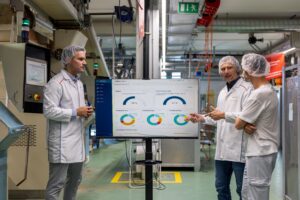After a construction period of 20 months and an investment of about CHF 50 million, Bühler Group has officially opened its CUBIC innovation campus with eight Application Centres. “We are with this driving forward out strategy of innovation, training and development,” says Stefan Scheiber, CEO of Bühler Group. “Together with our customers, partners from industry and science, academia and start-ups, we are using the CUBIC to conduct research into new and sustainable solutions that we can apply to successful business ventures. And, we are taking a step forward here in providing modern training and development,” says Scheiber.
The global challenges associated with nutrition and mobility are becoming increasingly urgent. How can we sustainably feed and provide mobility for a population of nearly 10 billion in 2050? Addressing these issues and responding to them with sustainable, commercially attractive solutions is the goal of the innovation campus. “This is our contribution to transforming the urgent global challenges of our time into solid business solutions together with customers, partners, academia, and start-ups,” says Stefan Scheiber, CEO of Bühler Group. “In this campus, we are also promoting new professional skills and competencies, modern learning and working methods, and collaborating with our partners.” Every year, the company invests a sum in the three-digit millions in research and development (R&D). In 2018, this amounted to CHF 145 million or 4.4% of turnover.
The three-story CUBIC is designed to accommodate up to 300 people, and is, in itself, a model of sustainability and innovation. The building uses 15% less energy than comparable structures of its size. Its smart electrochromic glass facade was coated on equipment from Bühler Leybold Optics. This enables Bühler to slash energy consumption for heating and air-conditioning by as much as 50%. Building sensors measure carbon dioxide levels, air humidity, temperature, and flow of people to continuously fine-tune the functionality and energy consumption of the CUBIC. On the basis of this smart building concept, Bühler expects to be able to sustainably optimize the operation of the building. The CUBIC complies with the sustainability standards of Leed (Leadership in Energy and Environment Design), which certified the structure by awarding it a gold rating.
In terms of its design concept, the new innovation campus is integrated into the Bühler site in Uzwil as the bridge that links the development, engineering, and design teams with the modernized Application Centres and the factory. This enables Bühler to develop solutions together with customers, start-ups, and industry and research partners up to the point of market maturity with much higher speed and efficiency. The CUBIC represents Bühler’s purpose of “Innovations for a better world” and it focuses on promoting new training and development methods. Among other things, it embraces the dual education system of Switzerland, housing apprentices and academics, as well as youth and experience.
Project teams from all Bühler business areas currently reside in the CUBIC. Many of them are developing digital solutions, including Bühler Insights, a cloud-based IoT platform for digital services, which was created in close partnership with Microsoft. About 20% of the R&D budget went into the development of digital solutions in 2018.
“The CUBIC campus will become the epicentre of our collaborative ecosystem,” says CTO Ian Roberts. “It embodies our innovation spirit and culture, where we will inspire, discuss, understand, and derive actions that will support us as an industry to create more sustainable value chains, while contributing to addressing the burning environmental and societal challenges of our time.”
Vital elements of the new innovation campus are its eight modernized Application Centres. The ideas of customers and prototypes are tested in the Application Centres, where they are refined up to the point of market maturity.
In the Battery Lab, researchers are continuing their efforts to develop a new, continuous process for mixing electrode slurries applied in the manufacture of lithium-ion batteries. In the Grinding & Dispersing Application Centre, Bühler is developing wet grinding and dispersion solutions, for example for making printing inks. In the Die Casting Application Centre, five die-casting cells are installed for training operators and for conducting customer tests. Many of these developments are already incorporated into modern applications for the e-mobility industry.
In the Pasta Application Centre, the latest pasta is being developed, for example high-protein pasta containing flour from pulses or products with a proportion of microalgae. The Grain Technology Centre, at 3,000 square meters, is the world’s largest Grain Milling Application Centre. It also has its own Analytics Lab. Among other things, the Nutrition Application Centre develops textured vegetable proteins –alternatives for the growing number of flexitarians. Together with customers, the Bakery Innovation Centre develops wholesome, fresh bakery products.
In the Chocolate Application Centre, new flavours and novel processes for cocoa-based products are tested. In the Coffee Application Centre, customers test low-energy roasting processes to develop new taste variants. The CUBIC and the Application Centres will be presented to Bühler’s partners from industry and academia on the occasion of the Bühler Networking Days 2019. On August 26 and 27, 2019, Bühler expects to welcome nearly 800 guests from process industries around the world to this event.








